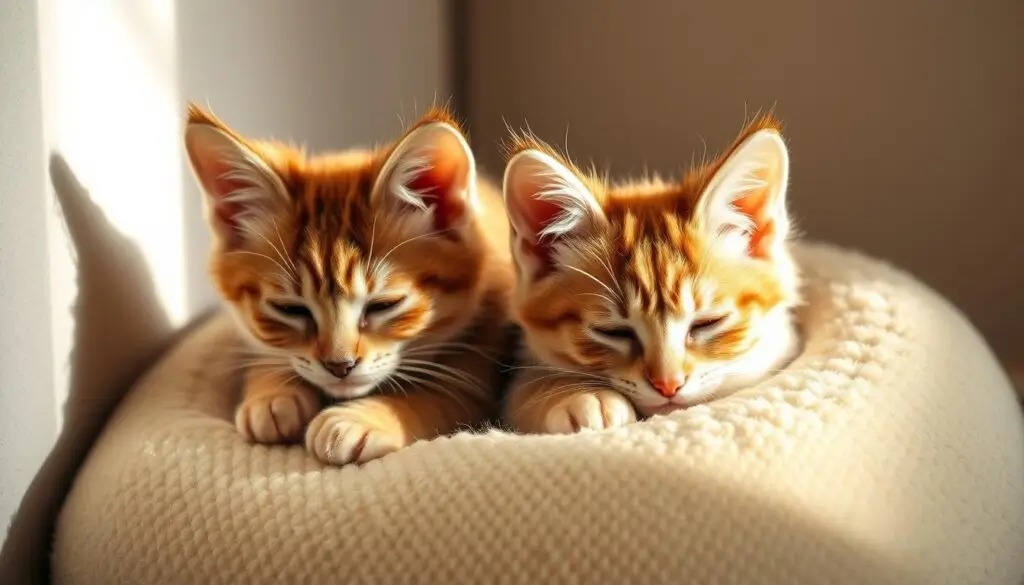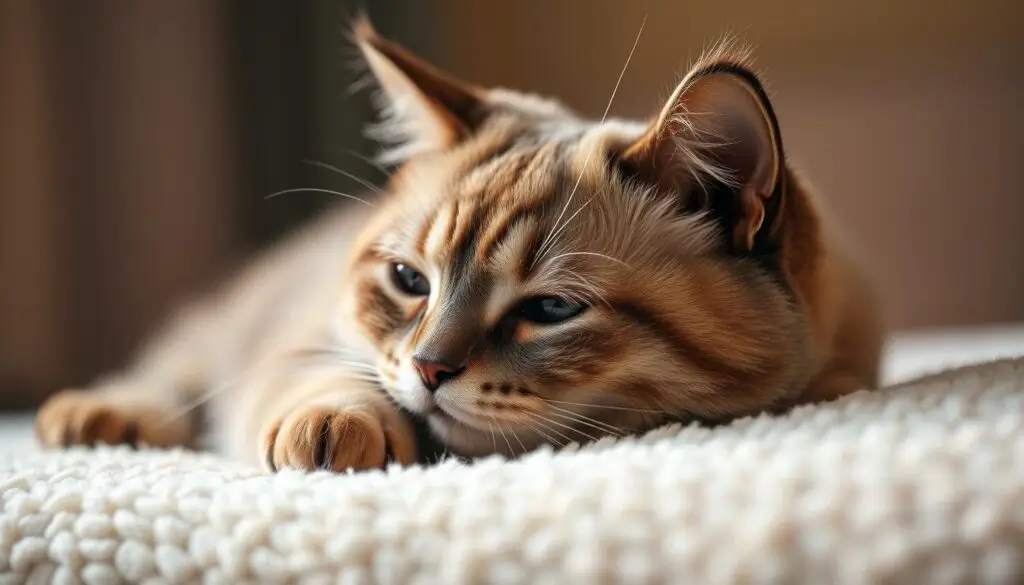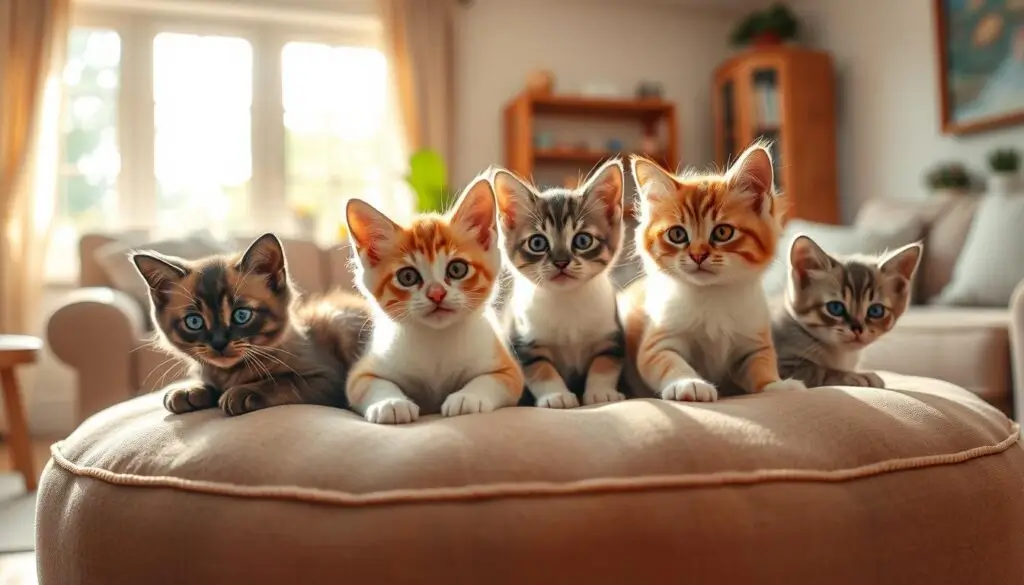Discover The Most Popular Small Cat Breeds For Families
Imagine a cat that fits perfectly on your lap and loves to play. Small cat breeds like the Singapura and Munchkin are perfect for families. They are tiny but have big hearts and lots of energy.
These cats are great for busy homes with kids or limited space. They love to be around people and play. This guide will help you find the perfect small cat for your family.
Table of Contents
Key Takeaways
- Singapura cats, the world’s smallest breed, weigh just 4-8 pounds, half the size of average cats.
- Munchkin cats have short legs and weigh 4-9 pounds, making them ideal for homes with children or seniors.
- Devon Rex cats crave companionship and need daily interaction to stay happy, per the Cat Fanciers’ Association.
- Teacup cats may face health risks like heart issues, so prioritize verified breeds like the Korat or Toybob.
- Ragdolls and American Shorthairs combine small frames with gentle temperaments, easing transitions into family life.
Understanding Why Small Cat Breeds Make Excellent Family Pets
Choosing a pet depends on space and lifestyle. Small cat breeds and compact cat breeds are great for modern families. They do well in apartments, condos, or smaller homes.
Their size means they need less space for play or rest. This makes them perfect for city living.
Space-Saving Companions for Modern Homes
Small cat breeds like the Singapura weigh under 5 pounds. They fit easily into small spaces. Even the Munchkin, with short legs, needs less space than big cats.
They also require less furniture cleaning and scratching post space. This is because of their compact size.
Lower Maintenance Requirements
Caring for compact cat breeds is easier and saves time. They eat less food, like the Cornish Rex needing 30% less calories. Their waste is also easier to manage.
Smaller litter boxes fit well in homes. Many families choose small cat breeds for simpler vet visits. The Devon Rex, for example, rarely weighs over 8 pounds, making vet trips stress-free.
Advantages for Families with Children
These cats are often gentle. The Burmese is known for being patient with kids. Their small size means they’re less likely to knock things over.
They also have the same playful energy as kids. The Sphynx, a hairless breed, is even hypoallergenic. This reduces allergies while still offering lots of love.
“A cat’s size doesn’t limit its personality—small breeds bring big love into small spaces.” – Dr. Emily Carter, Pet Behavior Specialist
Small cat breeds save space and simplify care. They adapt well to family life. This makes them a smart choice for those who value convenience and joy.
The Top 10 Small Cat Breeds Perfect for Family Living
Choosing the right small feline companion starts with exploring breeds that thrive in family settings. These tiny cat breeds offer diverse personalities, from playful to serene. This ensures there’s a match for every household. Let’s dive into the top 10 tiny cat breeds and their standout traits.
- Singapura: The world’s smallest breed at 4–6 lbs, this tiny cat breed bonds deeply with owners. Over 65% of Singapura cats exhibit dog-like loyalty, making them ideal for affectionate families.
- Munchkin: Weighing 6–9 lbs, these playful cats enjoy playtime with kids. 70% of owners report positive interactions with other pets, thanks to their social nature.
- Devon Rex: With oversized ears and a playful spirit, Devon Rex cats thrive in active homes. Their 12–15 year lifespan suits long-term family companionship.
- Cornish Rex: Shed minimally, making them a top choice for allergy-conscious families. Their sleek coat reduces dander, aligning with 50% of owners’ needs.
- American Curl: Recognized by their curled ears, these cats adapt well to busy households. Their calm demeanor suits families seeking low-stress companions.
- Abyssinian: Weighing 6–10 lbs, these curious explorers delight in interactive play. Over 60% of owners praise their playful antics with toys and puzzles.
- Japenese Bobtail: Their chatty nature (75% vocal) makes them talkative companions. Their triangular tails add charm to any living space.
- Russian Blue: Calm and affectionate, this breed’s short coat needs minimal grooming. Their 15–20 year lifespan offers long-term companionship.
- Balinese: A graceful Siamese relative, they bond easily with children. Their 15–20 year lifespan ensures lasting family bonds.
- Dwelf: A rare hybrid, Dwelfs weigh 4–6 lbs and crave attention. 80% of owners note their clingy nature suits families seeking constant companionship.
Every breed on this list balances size with distinct personalities. Upcoming sections explore these small feline breeds in depth. This helps you align their traits with your family’s lifestyle. Consider their activity levels, shedding patterns, and social preferences to find the perfect match.
American Shorthair: A Compact Classic for American Households
The American Shorthair is a favorite among small cat breeds. They are 8–10 inches tall and weigh 10–15 pounds. This makes them both athletic and cozy.
Their history goes back to early American cat shows. They were recognized by the Cat Fanciers’ Association in 1906. Now, they are known for their intelligence and calm nature, making them great for families.
Temperament and Personality Traits
These cats love to solve puzzles and learn tricks. They are playful but also calm, even in busy homes. Their mix of curiosity and composure makes them special.
They are affectionate but also like to have their space. This makes them perfect for those who want a cat that is both loving and independent.
Care Requirements and Lifespan
- Health: Regular dental care is critical—over 50% of cats face periodontal disease.
- Longevity: With proper care, they often reach 15–20 years, among the longest-lived little cat breeds.
- Grooming: Weekly brushing maintains their short coat, avoiding matting.
Compatibility with Children and Other Pets
They are patient with kids and enjoy playing with them. But they also get along with dogs and cats. Just remember, they might chase birds or small animals.
Starting socialization early helps them get along well with other pets. This makes them a great addition to any family.
Munchkin Cats: The Petite Felines with Short Legs
Meet the Munchkin, a small cat breed known for its short legs and playful nature. They were recognized by The International Cat Association (TICA) in 1991. These cats weigh between 4 and 9 pounds and keep a kitten-like curiosity as adults.
Their unique build is caused by a special gene. This creates a distinctive look that’s both charming and unique.
- Weight: Males average 6–9 lbs; females 4–8 lbs.
- Personality: Known for sprinting speeds and a prairie-dog-like upright stance, they thrive on interactive play.
- Health notes: While prone to joint concerns, many live healthily with proper care.
Munchkins are small but strong companions. Their short legs don’t slow them down. They love to race after toys or balance on hind legs for treats.
Despite their genetic uniqueness, they’re social and affectionate. This makes them great for families. However, their breeding is restricted in places like the Netherlands due to ethical debates. It’s important to research reputable breeders.
Munchkins show that small breeds can bring a lot of joy. Their history goes back to the 1980s in Louisiana. While some debate their recognition, their popularity is growing. Owners love their lively personalities.
Singapura: The World’s Smallest Cat Breed
The Singapura is a tiny cat marvel. It comes from Singapore and was first seen in the 1970s. The International Cat Association (TICA) recognized it in 1979. By 1988, it became a champion, joining the diminutive cat breeds group.
Origin and History
At first, people thought the Singapura came from Singapore’s streets. But, studies showed it actually came from American cats sent to Asia. It’s still loved as Singapore’s “national cat.” It’s the smallest natural cat breed, weighing 4–6 pounds.
Behavioral Characteristics
These cats are big in personality, despite their small size. They are curious, talkative, and love people. They enjoy climbing and playing with toys, making them great for families. But, they don’t like being left alone.
Health Considerations for Singapura Cats
These cats are generally healthy but have some genetic issues. A 2007 study found they had low genetic diversity. Since 2013, UK breeders have allowed them to crossbreed. Watch for anemia and uterine problems. Regular vet visits and the right diet are key to their long life.
| Breed | Weight Range (lbs) |
|---|---|
| Singapura | 4–6 |
| Munchkin | 5–8 |
| Devon Rex | 5–10 |
| Cornish Rex | 6–10 |
| Sphynx | 6–12 |
Looking after a diminutive cat breed like the Singapura needs careful diet and socialization. They need the right food to avoid getting too fat. With the right care, Singapuras can live up to 15 years, showing that size doesn’t matter.
Devon Rex and Cornish Rex: The Diminutive Breeds with Unique Coats
The Devon Rex and Cornish Rex are standout miniature cat breeds. They have whimsical curls and are small in size. These cats are playful and have soft, wavy fur, making them great companions.

Comparing Devon and Cornish Rex Temperaments
- Devon Rex: These cats love to play and often jump high. They have big ears and a mischievous look.
- Cornish Rex: They are graceful and playful, enjoying games and following their owners. Both breeds love attention but in different ways.
Grooming Needs for Curly-Coated Breeds
These cats have fluffy fur but need little brushing. Their fur sheds less, which is good for people with allergies. A weekly wipe with a damp cloth keeps their fur looking great.
They need baths every 4–6 weeks to avoid oil buildup. It’s important to watch out for their sensitive skin. Keeping them away from too much sunlight and using warm bedding helps them stay happy in cold weather.
These cats are smart and loving, bringing endless joy to their owners. Their easy-to-maintain fur and lively nature make them perfect for families looking for a small but lively pet.
Essential Care Tips for Miniature Cat Breeds in Family Settings
Miniature cat breeds need special care to thrive in families. Focus on the right food, safe places, and regular health checks. This meets their unique needs.
- Nutrition: Feed them 2-3 times a day. Choose kibble that’s easy for them to eat to avoid choking.
- Habitat: Use small litter boxes with easy access. Give them cozy spots like high perches for safety.
- Exercise: Play with them daily using feather wands or puzzle toys. This keeps their energy in check.
| Breed | Average Weight | Litter Box Size |
|---|---|---|
| Singapura | 4–8 lbs | 10-inch compact |
| Munchkin | 6–9 lbs | 12-inch standard |
| Devon Rex | 6–9 lbs | 12-inch shallow |
Grooming depends on their fur type. Brush them weekly to remove loose hair. Use a grooming mitt to cut down on allergens. Small feline breeds might have health issues, so see the vet yearly. Watch for signs of arthritis in Munchkin cats and avoid overfeeding to prevent obesity.
Teach kids how to handle these tiny pets gently. Keep small items out of reach to stop them from swallowing things. By following these care tips, miniature breeds can live happily with your family.
Addressing Common Concerns About Small Cat Breeds

Thinking about getting a compact cat breed? You might be worried about health, myths, or costs. Here’s what you need to know.
Health Issues Specific to Compact Breeds
Some tiny cat breeds have special health needs. For example, Munchkin cats have a leg issue that needs gentle stairs. The Singapura, one of the smallest, needs extra care because of its size.
Regular vet visits are key to managing health issues. This includes dental problems from small jaws and genetic conditions. Look for breeders who do health screenings.
Dispelling Myths About Tiny Feline Companions
Myth: Tiny cats are fragile. Fact: Many live over 15 years. Siamese cats can live up to 20 years with good care.
Myth: All small cats are hypoallergenic. Fact: Allergens come from dander, not size. Russian Blues shed less but aren’t fully hypoallergenic.
Myth: Small breeds lack energy. Fact: Munchkins are fast and playful, despite their short legs.
Cost Considerations for Specialized Breeds
Getting a compact cat breed might cost more. Here’s a comparison of prices for some breeds:
| Breed | Adoption Cost | Key Notes |
|---|---|---|
| Singapura | $800–$1,500+ | Rare, requires premium diets. |
| Munchkin | $1,000–$1,800 | Genetic testing recommended. |
| Devon Rex | $800–$1,200 | Low-shedding but needs social interaction. |
Plan for vet visits and special diets. You can also find lower-cost options at rescues.
How to Choose the Right Small Feline Breed for Your Family
Choosing the perfect small feline breed begins with knowing your home and lifestyle. Think about the space, how active you are, and what your family needs. This guide offers simple steps to help you choose.
Assessing Your Living Situation
First, look at your home. Little cat breeds like the Singapura do well in apartments but need places to climb. If you’re often out, breeds like the calm American Shorthair might be better than the energetic Abyssinians. If your cat will go outside, consider breeds like the Munchkin, which need safe areas.
Matching Breed Personalities to Family Dynamics
| Breed | Key Trait | Best For | Considerations |
|---|---|---|---|
| Singapura | Curious, playful | Active households | Needs interactive toys |
| Cornish Rex | Curious, affectionate | Busy families | Low shedding, but prone to myopathy |
| American Shorthair | Adaptable, gentle | Quiet homes with kids | Regular vet checks recommended |
Questions to Ask Breeders or Shelter Staff
- What are common health issues for this breed?
- Are there genetic conditions to monitor?
- How much daily interaction does this breed need?
- What grooming routines are necessary?
Always ask about the cat’s temperament and health history. It’s important to meet the cat in person. Responsible breeders will tell you about any health risks, like the Cornish Rex’s myopathy or the Singapura’s need for activity.
Where to Adopt Little Cat Breeds Responsibly
Looking for a small cat? Choose places that care about the cat’s health and happiness. Stay away from sellers who use fake terms like “teacup” without health promises.
“Adopt, don’t shop”—a mantra driving more families to shelters and rescues over commercial breeders.
There are three good ways to adopt a cat:
- Breeders: Find ones who focus on health, not money. They should show genetic tests and socialization proof.
- Rescue Organizations: Look for groups like the Singapura Rescue Network or Munchkin Rescue Alliance.
- Shelters: Use sites like Petfinder.com and ASPCA.org to find small cats looking for homes.
| Criteria | Reputable Breeders | Rescue Organizations | Shelters |
|---|---|---|---|
| Health Records | Must provide parent health certificates | Includes vaccinations | Basic exams available |
| Adoption Fees | $500–$2,000+ for purebreds | $200–$400 with spay/neuter included | $50–$150, often discounted |
| Age Requirements | 12–16 weeks minimum | Varies by cat’s age | Any age, including adults |
Good breeders let you visit their place to see how kittens live. They should show FIV/FeLV tests and a spay/neuter contract. Don’t pay less than $300, and kittens should be at least 8 weeks old. They should also have a health certificate within 7 days of adoption.
Shelters have small, mixed-breed cats that are cheaper than purebreds. Meet them to see if you’re a good match. Shelters let you return a cat if it doesn’t work out, keeping everyone safe.
Conclusion: Bringing Your New Small Cat Breed Companion Home
Getting a small cat breed is the beginning of a wonderful journey. Make a cozy space with scratching posts, beds, and safe spots. Cats like the Singapura or Devon Rex do well in homes that fit their size and energy.
Keep important things like a litter box, toys, and food in quiet places. This helps them feel at home faster.
The first days are very important. Slowly introduce your cat to family and other pets. Look for signs of stress like flattened ears or hiding. Give them time to get used to their new home.
Small breeds like the Burmese or Cornish Rex might adjust quickly. But they still need patience. Regular vet visits are key to keep them healthy, especially for breeds with special health needs like the Sphynx.
Start routines to build trust. Feed them at the same times and play every day. High-energy cats like the Munchkin need fun toys, while calm cats like the Persian like quiet spots.
Watch how they use the litter and eat. This helps spot health issues early. As time goes on, your cat will become more confident and show their playful or loving side.
Small cat breeds can be friends for 12–20 years. They fit well in apartments or big houses. Feed them well to avoid obesity, a big problem. Join online groups to share tips and learn from others. These small cats may be small, but their love and personality are huge.

